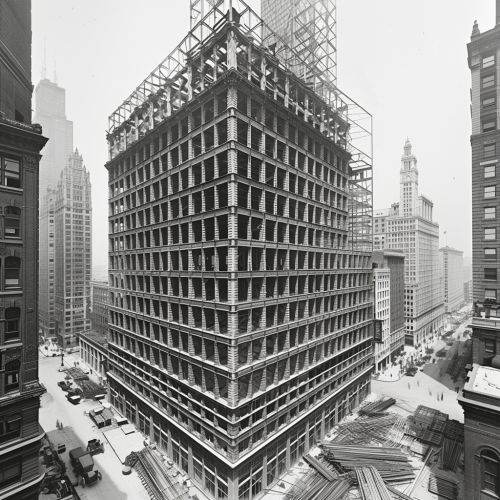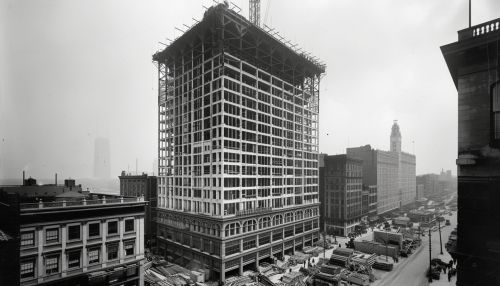History of skyscrapers
History of Skyscrapers
The history of skyscrapers is a fascinating journey through architectural innovation, technological advancements, and urban development. This article delves into the evolution of skyscrapers, from their inception in the late 19th century to their current status as iconic symbols of modern cities.
Early Developments
The concept of the skyscraper emerged in the late 19th century, primarily in the United States. The term "skyscraper" originally referred to buildings that were significantly taller than their surroundings. The development of skyscrapers was driven by several factors, including the need for more office space in rapidly growing urban centers, advancements in building materials, and the invention of the elevator.
The Home Insurance Building in Chicago, completed in 1885, is widely regarded as the world's first skyscraper. Designed by architect William Le Baron Jenney, this ten-story building utilized a steel frame structure, which allowed for greater height and stability compared to traditional masonry construction. The use of steel frames became a defining characteristic of skyscrapers, enabling architects to design taller and more slender buildings.


The Chicago School
The Chicago School of architecture played a crucial role in the development of skyscrapers. This movement, which emerged in the late 19th and early 20th centuries, emphasized functional design and the use of new materials and technologies. Architects such as Louis Sullivan, Daniel Burnham, and John Wellborn Root were instrumental in shaping the early skyline of Chicago.
Sullivan, often referred to as the "father of skyscrapers," is known for his belief that "form follows function." His designs, including the Wainwright Building in St. Louis, showcased the potential of steel frame construction and large windows, which allowed for more natural light and better ventilation.
The New York Boom
While Chicago was the birthplace of the skyscraper, New York City quickly became the epicenter of skyscraper development in the early 20th century. The city's limited land area and growing population created a demand for vertical expansion. The Flatiron Building, completed in 1902, was one of the first skyscrapers to become an iconic symbol of New York.
The Chrysler Building, completed in 1930, and the Empire State Building, completed in 1931, epitomized the Art Deco style and represented the pinnacle of skyscraper design during this period. The Empire State Building, standing at 1,454 feet (including its antenna), held the title of the world's tallest building for nearly four decades.
Post-War Modernism
The post-World War II era saw significant advancements in skyscraper design and construction. The International Style, characterized by minimalism and the use of glass and steel, became the dominant architectural trend. The Lever House and the Seagram Building in New York City are prime examples of this style.
Architects such as Ludwig Mies van der Rohe and Philip Johnson were influential in promoting the International Style. Mies van der Rohe's dictum "less is more" encapsulated the aesthetic of this period, which favored clean lines and functional design over ornamentation.
Technological Innovations
Technological advancements have played a crucial role in the evolution of skyscrapers. The development of elevator technology, particularly the safety elevator invented by Elisha Otis in 1853, made tall buildings practical by allowing people to move quickly and safely between floors.
The introduction of reinforced concrete and prefabrication techniques further revolutionized skyscraper construction. Reinforced concrete, which combines steel reinforcement with concrete, provided greater strength and flexibility, allowing for more daring architectural designs.
The Rise of Supertall Skyscrapers
In recent decades, the race to build the tallest skyscrapers has intensified, leading to the emergence of "supertall" buildings, defined as those exceeding 300 meters (984 feet) in height. The Burj Khalifa in Dubai, completed in 2010, currently holds the title of the world's tallest building at 828 meters (2,717 feet).
The construction of supertall skyscrapers involves complex engineering challenges, including wind resistance, structural stability, and vertical transportation. Innovations such as tuned mass dampers, which counteract the effects of wind, and double-decker elevators have been developed to address these challenges.
Environmental Considerations
As concerns about sustainability and environmental impact have grown, the design and construction of skyscrapers have increasingly incorporated green building practices. The Leadership in Energy and Environmental Design (LEED) certification, developed by the U.S. Green Building Council, has become a standard for evaluating the environmental performance of buildings.
Skyscrapers such as the Bank of America Tower in New York City and the Shanghai Tower in China have achieved high levels of LEED certification by incorporating features such as energy-efficient systems, green roofs, and rainwater harvesting.
Cultural and Social Impact
Skyscrapers have had a profound impact on the cultural and social fabric of cities. They have become symbols of economic power, technological prowess, and modernity. The skyline of a city, often defined by its tallest buildings, has become a key aspect of its identity and a source of civic pride.
However, skyscrapers have also been associated with issues such as urban density, gentrification, and social inequality. The concentration of wealth and power in high-rise office buildings and luxury residential towers has raised questions about the equitable distribution of resources and opportunities in urban environments.
Future Trends
The future of skyscrapers is likely to be shaped by ongoing technological advancements, environmental considerations, and changing social dynamics. Innovations such as smart building technologies, which use sensors and data analytics to optimize building performance, are expected to become increasingly prevalent.
The integration of mixed-use development, which combines residential, commercial, and recreational spaces within a single building, is also likely to continue. This approach aims to create more vibrant and sustainable urban environments by reducing the need for commuting and promoting a sense of community.
Conclusion
The history of skyscrapers is a testament to human ingenuity and the relentless pursuit of progress. From the early steel-framed buildings of Chicago to the soaring supertalls of today, skyscrapers have transformed the way we live and work, reshaping the urban landscape and pushing the boundaries of what is possible in architecture and engineering.
